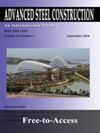火灾中半刚性接头性能预测的人工神经网络模型
IF 1.7
3区 工程技术
Q3 CONSTRUCTION & BUILDING TECHNOLOGY
引用次数: 8
摘要
本文提出了一种人工神经网络(ANN)模型,用于预测半刚性裸钢节点在高温下的行为。考虑了三个平直端板和一个柔性端板关节的数据。该模型以关节部件几何形状、关节材料特性、关节温度和施加力矩等16个参数为输入变量,以关节旋转为主要输出参数。实验火灾测试数据用于训练和测试模型。总共评估了15种不同的测试结果,分别使用了331个和61个案例对所开发的模型进行了训练和测试。将模型预测值与实际试验结果进行了比较。结果表明,该模型能很好地预测火灾中的矩转行为。模型训练和验证的决定系数(R)分别为0.964和0.956。本文章由计算机程序翻译,如有差异,请以英文原文为准。
An artificial neural network model for predicting the behaviour of semi-rigid joints in fire
This paper presents an artificial neural networking (ANN) model developed to predict the behaviour of semi-rigid bare-steel joints at elevated temperature. Data for three flush end-plate and one flexible end-plate joints were considered. Sixteen parameters which included geometry of the joint’s components, material properties of the joint, joint’s temperature and the applied moment were used as the input variables for the model whilst the joint’s rotation was the main output parameter. Data from experimental fire tests were used for training and testing the model. In total, fifteen different test results were evaluated with 331 and 61 cases were used for training and testing the developed model, respectively. The model predicted values were compared with actual test results. The results obtained indicated that the model can predict the moment-rotation behaviour in fire with very high accuracy. The coefficients of determination (R) for training and validation of the model were 0.964 and 0.956, respectively.
求助全文
通过发布文献求助,成功后即可免费获取论文全文。
去求助
来源期刊

Advanced Steel Construction
CONSTRUCTION & BUILDING TECHNOLOGY-ENGINEERING, CIVIL
CiteScore
2.60
自引率
29.40%
发文量
0
审稿时长
6 months
期刊介绍:
The International Journal of Advanced Steel Construction provides a platform for the publication and rapid dissemination of original and up-to-date research and technological developments in steel construction, design and analysis. Scope of research papers published in this journal includes but is not limited to theoretical and experimental research on elements, assemblages, systems, material, design philosophy and codification, standards, fabrication, projects of innovative nature and computer techniques. The journal is specifically tailored to channel the exchange of technological know-how between researchers and practitioners. Contributions from all aspects related to the recent developments of advanced steel construction are welcome.
 求助内容:
求助内容: 应助结果提醒方式:
应助结果提醒方式:


